If you’re lucky enough to have met Rob, you’ll know that he is understated and unlikely to exaggerate his impressions. He’ll happily enough acknowledge that his wines are (more than) “drinkable”, but you won’t find him banging on about it!
That’s why his latest update from the winery has got me very excited! Read between the lines with me and you’ll discover we’re going to have an outstanding line-up of wines from vintage 2018.
Let’s have a look at Rob’s report from the winery today in his own words, with a translation here and there from me (which may or may not reflect the stated views of the winemaker!)…
Report on visit to Lodestone Winery – 24 May, 2018
Looked at all the wines and happy with all of them.
(See what I mean by understated?! Happy = ecstatic)
Sauvignon Blanc
Still cloudy in the tank, but the colour is great (awesome) – pale, with some of those nice green tints that reflect the early picking and really nice (top quality) fruit.
The nose is very delicate – slightly herbaceous rather the floral. The palate is crisp. Too crisp for drinking at this stage, but we’ll be chilling the wine to ensure cold stability next week, and that will ease back the acid level.
Cold stabilisation
In some bottles of wine you may see a small deposit of crystals, particularly if the bottle has been stored in the refrigerator. These deposits are tartrate crystals – a natural part of the wine; they precipitate out under cold conditions. They are not harmful, however most consumers prefer their wine to be perfectly clear (particularly white wine).
To ensure this winemakers will, after fermentation, chill the wine and hold it at about minus 3 degrees Celsius to precipitate all or most of the unstable tartrate crystals before the wine is bottled.
Flavours are delicate too, but with a nice lingering finish. (The 2018 version of this Somerled favourite is going to be delicious, as usual!)
Fumé Blanc
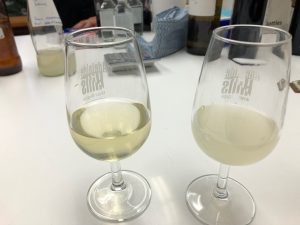
Already darker in colour than the “standard” Sauvignon Blanc. This is due to its time in the barrel, with colour from the oak showing up. Seeing as it has had only a short time in barrel, it’s impressive (high praise indeed!) to see that extra colour and even more so to see the enriching of the aromas and flavours. The malolactic fermentation has influenced the nose and palate in a very nice way so that the wine is already starting to show complexity and interest (damn, this wine is going to be great! …or something like that). It’s being stirred on a fortnightly basis. This stirs up the lees from the bottom of the barrel, helping to develop a fuller texture and flavour. It helps the bacteria to keep going too, as the malolactic fermentation hasn’t finished yet.
Chardonnay
This is showing colour development too! (exclamation marks?! He must really be excited!) It’s even a bit deeper than the Fumé, and with really nice tints. The nose is quite full, and the ongoing malolactic fermentation is adding such a nice (delightful) extra lift to the nose – almost a maturity to it.
The palate has quite a dense flavour and it really lingers. There are some nice oak aromas and flavours, and it’s almost savoury rather than fruity. It’s going really well (OMG… Heather is going to love this!).
Pinot Rosé
Pale and very dry as all good rosés should be. It’s not showing a great deal in the way of malolactic fermentation (MLF) influence – aromas and flavours are still “pinot fruit” without strong complexing effect from the MLF. But that will come. We’ll have an update on the progress of the MLF tomorrow. It’s still very crisp, so further MLF will be ideal to soften it up!!
Pinot Dry Red
This is looking very nice indeed. It’s all the way through MLF and sulphur dioxide has been added, as previously reported. It’s still quite cloudy so it will be pumped out of barrel into a tank and settled for a bit, then racked back into washed out barrels. The barrels will, apart from one new one, all be well matured, as we don’t want too much oak to show through. The nose is showing that lovely young pinot perfume that will get more prominent as it sits in barrel. I think that as the wine becomes clearer and less cloudy, those aromas will float up more easily. The palate is surprisingly rich for a pinot and has almost a sweetness about it, even though the residual sugar in the wine is negligible. It could be our best pinot dry red yet, as I think I’ve already said!! (more exclamation marks! Boy, I’m not sure I’ve ever seen rob THIS excited!)
HARVEST DAY – SUNDAY JUNE 3
Back by popular demand!
Paella paired with a glass of Tempranillo = match made in heaven!
Serving lunch at our next Harvest day on Sunday, June 3 and this time we’re supporting Catherine House – Support for Women Experiencing Homelessness and we’d love you to bring any of the following items:
- liquid body-wash
- facial cleanser
- facial moisturiser
- hair colour
- sunscreen
- deodorant spray.
We’ll then deliver our stash to Catherine House who will distribute them to women in need – these simple items will make a big difference.
Lunch $25 – Click here to book
Have a look at the Catherine House wish list here.
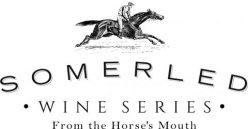
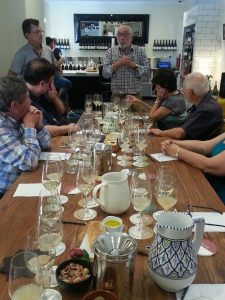
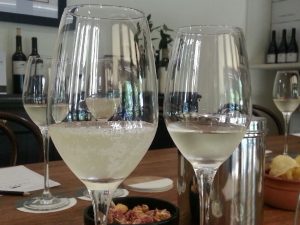 Sauvignon Blanc (ex-stainless steel tank): The aroma was at the tropical fruits end of the spectrum (think rockmelon and passionfruit). That’s because although the Adelaide Hills is classified as cool climate, Kim’s vineyard has an east facing aspect. The fruit takes on these attractive tropical flavours – rather than gooseberry, herbaceous notes. The young wine was still fizzy (see photo) as the ferment wasn’t complete at that stage, but not far off. This will be replaced with a crispness in the finished wine. As you can see, it was cloudy. Careful racking, fining and filtering will take care of that.
Sauvignon Blanc (ex-stainless steel tank): The aroma was at the tropical fruits end of the spectrum (think rockmelon and passionfruit). That’s because although the Adelaide Hills is classified as cool climate, Kim’s vineyard has an east facing aspect. The fruit takes on these attractive tropical flavours – rather than gooseberry, herbaceous notes. The young wine was still fizzy (see photo) as the ferment wasn’t complete at that stage, but not far off. This will be replaced with a crispness in the finished wine. As you can see, it was cloudy. Careful racking, fining and filtering will take care of that.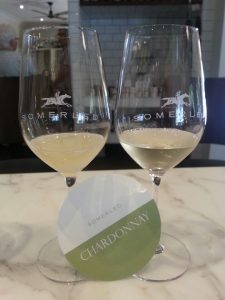 Chardonnay (ex-French oak barrels): Aromas of citrus (like grapefruit). It already exhibits its hallmark mouthfeel (think of that lovely creamy feeling you get with a good glass of chardy!) Its richness may be partly due to the bit of sugar which is still fermenting out. It’s certainly heading down the right track though.
Chardonnay (ex-French oak barrels): Aromas of citrus (like grapefruit). It already exhibits its hallmark mouthfeel (think of that lovely creamy feeling you get with a good glass of chardy!) Its richness may be partly due to the bit of sugar which is still fermenting out. It’s certainly heading down the right track though.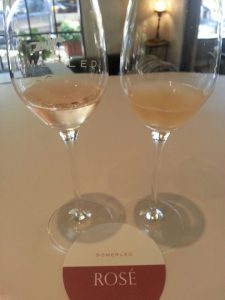 Rosé (ex-stainless steel tank): Looked like pink grapefruit juice, but had those lovely strawberry flavours we all love in this wine. It looked sweet compared with the 2017, but it will be quite dry by the time it gets to bottle.
Rosé (ex-stainless steel tank): Looked like pink grapefruit juice, but had those lovely strawberry flavours we all love in this wine. It looked sweet compared with the 2017, but it will be quite dry by the time it gets to bottle.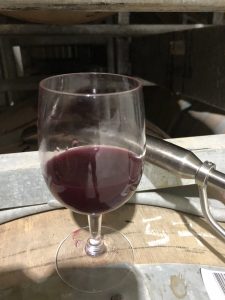
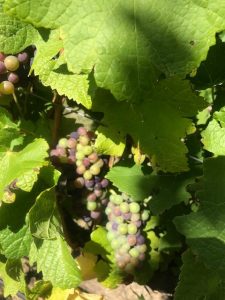 That said, there is still plenty happening…
That said, there is still plenty happening…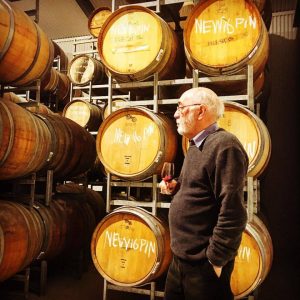 have a look at what’s happening behind the scenes with some of Rob’s creations which he is lovingly nurturing…
have a look at what’s happening behind the scenes with some of Rob’s creations which he is lovingly nurturing…